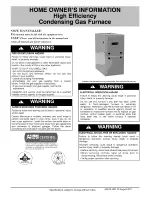
Page 41
Intake Piping
The SL297UHNV furnace is installed in
direct vent
appli
cations.
Follow the next two steps when installing the unit in
Direct
Vent applications,
where combustion air is taken from
outdoors and flue gases are discharged outdoors.
The
provided air intake screen must not be used in direct
vent applications (outdoors).
1 - Use transition solvent cement or a sheet metal screw
to secure the intake pipe to the inlet air connector.
2 - Route piping to outside of structure. Continue with in
stallation following instructions given in general guide
lines for piping terminations and intake and exhaust
piping terminations for direct vent sections. Refer to
table 21 for pipe sizes.
3 - Use a sheet metal screw to secure the intake pipe to
the connector, if desired.
General Guidelines for Vent Terminations
In Direct Vent applications, combustion air is taken from
outdoors and the flue gases are discharged to the out
doors. The SL297UHNV is then classified as a direct vent,
Category IV gas furnace.
In Direct Vent applications, the vent termination is limited
by local building codes. In the absence of local codes, re
fer to the current National Fuel Gas Code ANSI
Z223-1/NFPA 54 in U.S.A., and current CSA-B149 Natu
ral Gas and Propane Installation Codes in Canada for de
tails.
Position termination according to location given in figure
25. In addition, position termination so it is free from any ob
structions and 12” above the average snow accumulation.
At vent termination, care must be taken to maintain
protective coatings over building materials (prolonged
exposure to exhaust condensate can destroy protective
coatings). It is recommended that the exhaust outlet not be
located within 6 feet (1.8m) of an outdoor AC unit because
the condensate can damage the painted coating.
NOTE
- See table 23 for maximum allowed exhaust pipe
length without insulation in unconditioned space during
winter design temperatures below 32°F (0°C). If required
exhaust pipe should be insulated with 1/2” (13mm) Ar
maflex or equivalent. In extreme cold climate areas, 3/4”
(19mm) Armaflex or equivalent may be necessary. Insula
tion must be protected from deterioration. Armaflex with
UV protection is permissable. Basements or other en
closed areas that are not exposed to the outdoor ambient
temperature and are above 32 degrees F (0°C) are to be
considered conditioned spaces.
IMPORTANT
Do not use screens or perforated metal in exhaust
terminations. Doing so will cause freeze-ups and
may block the terminations.
IMPORTANT
For Canadian Installations Only:
In accordance to CSA International B149 installation
codes, the minimum allowed distance between the
combustion air intake inlet and the exhaust outlet of
other appliances shall not be less than 12 inches
(305mm).
















































